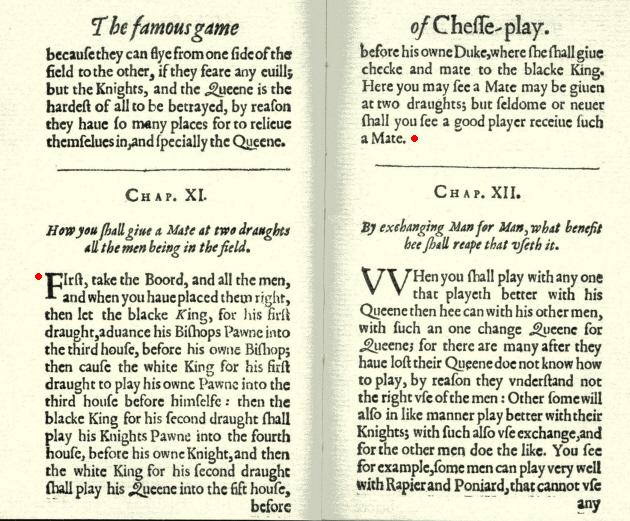
Edward Winter
An entry in the Oxford English Dictionary:
‘Fool’s mate n. Chess a form of game in which the first player, by two unwise moves, incurs checkmate at his adversary’s second move.
1618 J. Barbier Saul’s Famous Game Chesse-play (new ed.) xx. sig. E8, A Mate in two draughts ... which Mate for him that hath given him, may well ... be termd the fools mate.’
We should be grateful for a copy of the page in question, as well as any later citations illustrating the term’s progression into common parlance.
(7986)

The above illustration has been provided by Michael Clapham (Ipswich, England), who comments:
‘This is the relevant part of the London, 1614 edition of Arthur Saul’s The Famous Game of Chesse-Play. It comes from the facsimile edition published in 1974 by Walter J. Johnson, Inc. and Theatrum Orbis Terrarum, Ltd. Amsterdam.
This first chess manual by an Englishman is one of the rarest of early chess books. Further editions appeared in 1618, 1640, 1652, 1672 and 1680, all edited by J. Barbier.
Page 50 of David DeLucia’s book A Few Old Friends (Darien, 2007) states that only six copies are known of the first (1614) edition; the Beinecke Rare Book and Manuscript Library at Yale University reports that only two complete copies of the 1652 edition are known.
The other editions are probably similarly rare as they virtually never appear on the market, although copies of the 1640 and 1672 editions were included in the sale of the library of Robert Blass at Christie’s in 1992.’
David DeLucia (Darien, CT, USA) informs us that he has the third edition (1640) and that in Chapter XXIIII the following mates are mentioned:
‘The Queenes Mate
The Bishops Mate
The Knights Mate
The Rookes Mate
The Pawnes Mate
Mate of Discovery
Alexanders Mate
An unfortunate Mate
A Cowards Mate
The Blinde Mate
The Stale Mate
The Mate at two draughts, a Fooles Mate.’
Mr DeLucia adds:
‘I also have the fifth edition (1672), and the list of mates there is very similar to, if not the same as, the list in the 1640 edition.’
We should like to see the relevant text in the second edition (1618), i.e. the first in which the term ‘Fool’s mate’ appeared.
(7991)
Chess and How to Play It, a 90-page book by B. Scriven, was brought out by Universal Publications Ltd. in the late 1930s. From pages 37-38, after giving the game 1 g4 e5 2 f4 Qh4 mate:
‘This is undoubtedly a neat game to memorise, but it will be difficult to catch “old hands” with it.’
A national championship. Certain players collude by delaying games among each other in order to determine which of them has the best chance of unhorsing the tournament front-runner. One participant even throws a game, allowing himself to be mated on move two.
For information about this remarkable episode we are grateful to Luc Winants (Welkenraedt, Belgium), who writes as follows:
‘I would like to draw your attention to my own website, which is dedicated to the history of chess in Belgium. Concerning Koltanowski, about whom you have written recently in C.N., the account of the second Belgian Championship, held in Antwerp in September 1922, reveals some interesting details [http://users.skynet.be/jardinsdecaissa/belch/belch22.html – link no longer available]:
One chronicle, written by Edouard Verschueren, a friend of Edgard Colle, for La Flandre Libérale, 4 October 1922, states the following:
“C’est à ce moment que les joueurs anversois se sont liés contre le champion, dans l’espoir de lui ravir encore le titre. Volontairement on remettait des parties entre les joueurs anversois (Koltanowski-Dunkelblum), afin d’attendre le résultat de M. Colle et d’avantager alors le joueur ayant encore des chances; on lui cherchait toutes les difficultés possibles au jeu, tandis que, d’autre part, des parties entre Anversois finissaient dans des limites de temps ridicules, et ainsi M. Koltanowski gagnait la partie suivante contre M. Boruchowitz, ancien champion de Belgique:
1 f3 e5 2 g4 Dh4 mat. Ce n’est évidemment pas des parties pareilles qui donneront un lustre à nos joueurs anversois; le plus petit débutant aurait évité cette gaffe ... volontaire.”
Thus, as you can see, the game between Boruchowitz, the winner of the first championship in 1921, and Koltanowski finished after only two moves: 1 f3 e5 2 g4 Qh4 mate.’
Despite the plot against him Colle won the event and the national title, half a point ahead of Koltanowski.
(2928)
An eminent figure with an enthusiasm for chess was Sinclair
Lewis, who, in 1930, became the first American to win the Nobel
Prize in Literature. Over-the-board encounters with his one-time
secretary, the writer and artist Barnaby Conrad, were related in
Conrad’s memoir Fun While it Lasted (New York, 1969). From
pages 283-285: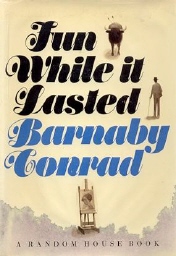
‘That night I played chess with Mr Lewis before dinner. I had studied chess for only a few weeks and had little talent for the game, but I managed to maneuver his king into a bad position fairly soon. I left to go to the bathroom, and when I returned I could swear the pieces had been moved to my disadvantage. But I didn’t say anything and I managed to win anyway. He seemed upset.
“Luck”, he snarled, “sheer luck!”
Then I remembered Marcella’s admonition: “You mustn’t win at chess – not too often, anyway. It’s the most important thing in his day.
He was a trifle sullen at dinner ... He had barely eaten half his dessert when he said, “Now my friend, we’ll see how much beginner’s luck was involved in that first game!”
... He sat down at the chess table and rubbed his hands with anticipation. He immediately set out to lure me into a Fool’s Mate – to beat me in a minimum of moves. Though it was one of the first maneuvers my instructor had showed me how to avoid, I let myself fall into the trap.
“Ah hah!”, he exulted. “That will show you!”
He was delighted and ate three chocolates in celebration. In a euphoric mood he bid me goodnight.’
Below is an inscription by Conrad in our copy of his book:
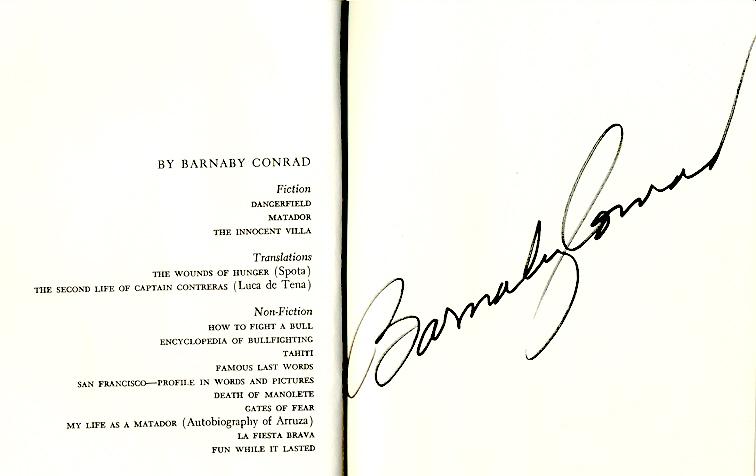
(4312)
John Blackstone (Las Vegas, NV, USA) submits this game:
A. Higuera – R. Solana
Pan American Masters’ Reserve Tournament, Hollywood, August 1945
From’s Gambit
1 f4 e5 2 g3 exf4 3 gxf4 Qh4 mate.
Source: column by Herman Steiner, Los Angeles Times, 8 August 1945, page A7.
(5045)
In C.N. 3295 (see pages 253-254 of Chess Facts and Fables) a correspondent drew attention to a passage from pages 10-11 of Cannibals in the Cafeteria by Stephen Pile (New York, 1988):
‘Gibaud has been overthrown. Ever since 1924 this French chess master has been revered for achieving defeat in only four moves. A Monsieur Labard [sic] played the walk-on part in this great scene.
But in the 1959 US Open Championship somebody called Masefield was a useful foil, moving around the white pieces in a match that enabled the immortal Trinka to be checkmated in three moves: 1 P-K4 P-KKt4; 2 Kt-QB3 P-KB4; 3 Q-R5 mate.’
In that C.N. item we mentioned having found no particulars about the alleged 1959 game in any contemporary source, and that remains the case today. As regards the players’ names, however, it may be noted that different versions appeared on page 30 of Das Spiel der Könige by Alfred Diel (Bamberg, 1983):
‘Die kürzeste Turnierpartie wurde 1959 bei der Offenen Meisterschaft von Omaha (USA) gespielt. Dabei wurde Trinks von Mayfield nach 1 e4 g5 2 Sc3 f5 mit 3 Dh5 mattgesetzt.’
(4493)
On page 64 of TV Chess G. Koltanowski affirmed that the game went 1 e4 f6 2 d4 g5 3 Qh5 mate and occurred between players named Mayfield and Trent at the US Open at St Louis.
(4506)
Concerning the alleged tournament game which ended with 3 Qh5 mate, John Timm (New York, NY, USA) draws attention to a report on the US Open Championship in Omaha, 1959 which includes participants named Mayfield and Trinks. Since we lack the two sources indicated in the report (Chess Life, 1959 and a book in the ‘American Tournament Series’ by Jack Spence) it will be appreciated if a reader can inform us whether they shed light on the three-move game.
(4994)
Below is the only instance we recall of a tournament game in which White gave mate at move two. Black offered the odds of his f-pawn, and the score appeared on page 239 of the July 1916 BCM:
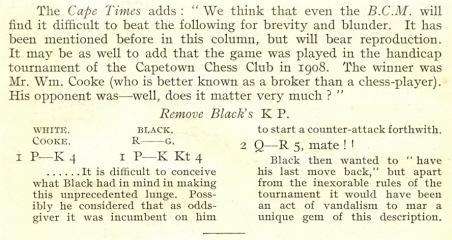
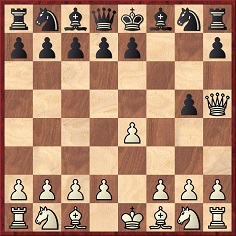
Position after 2 Qh5 mate
(5858)
Frederick S. Rhine (Park Ridge, IL, USA) draws attention to the following on page 4 of Chess Life, 20 October 1959:
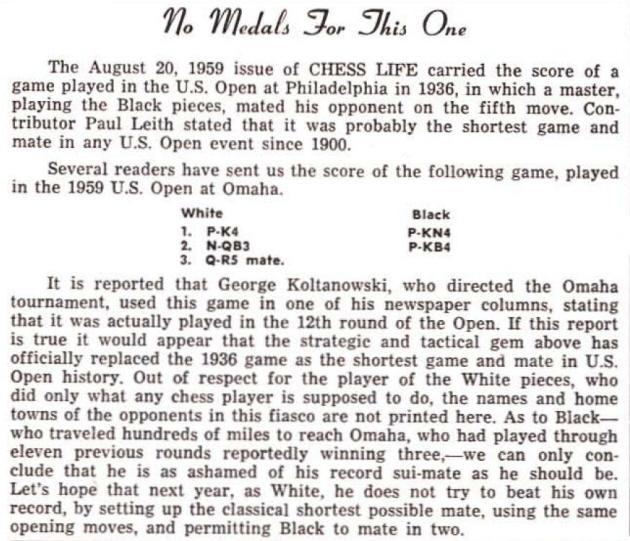
The game which had been given on page 3 of the 20 August 1959 Chess Life was F. Arnold v M. Hanauer, Philadelphia, 1936: 1 d4 Nf6 2 c4 e5 3 d5 Bc5 4 Bg5 Ne4 5 Bxd8 Bxf2 mate.
(6007)
The Fool’s mate (administered by White) is mentioned and shown in an episode of the television series Heartbeat, entitled ‘The Buxton Defence’, first broadcast in the United Kingdom on 1 April 2001. In a simultaneous display, the Russian champion Leonid Vorodin (Jalaal Hartley) mated Oscar Blaketon (Derek Fowlds) in three moves. The full episode, with a chess theme, is available on YouTube, and the Fool’s mate game begins at 17:05 and ends at 17:25.

See also Chess and Television.
To the Archives
for other feature articles.
Copyright Edward Winter. All rights reserved.